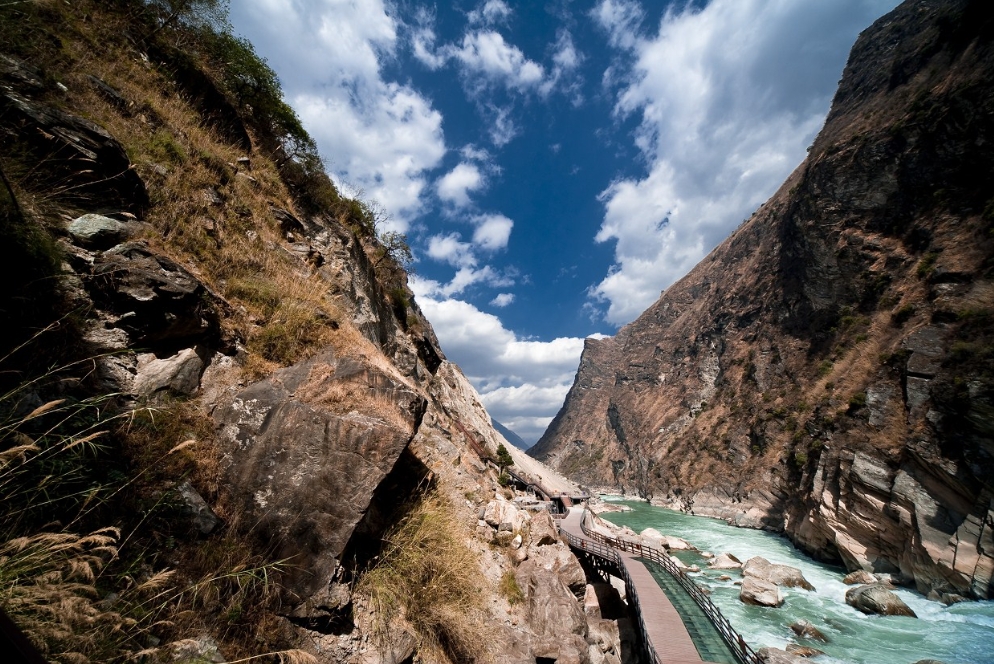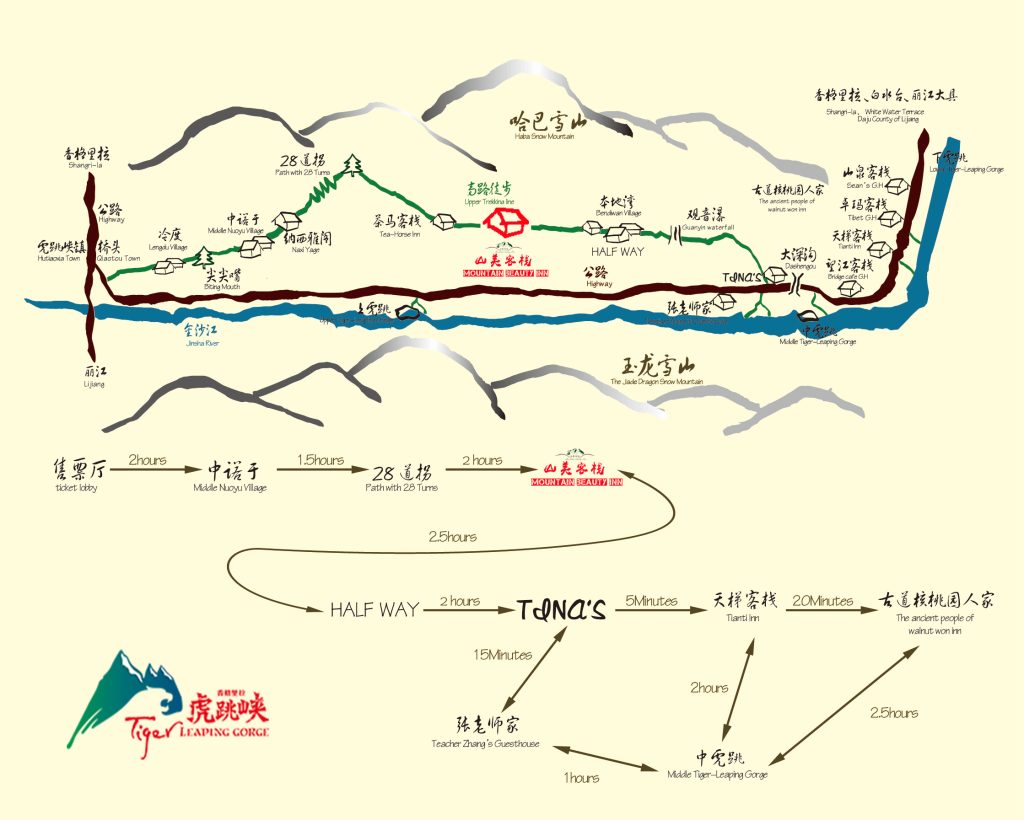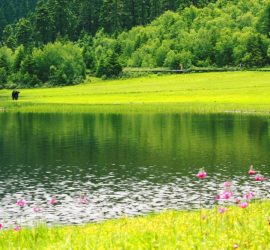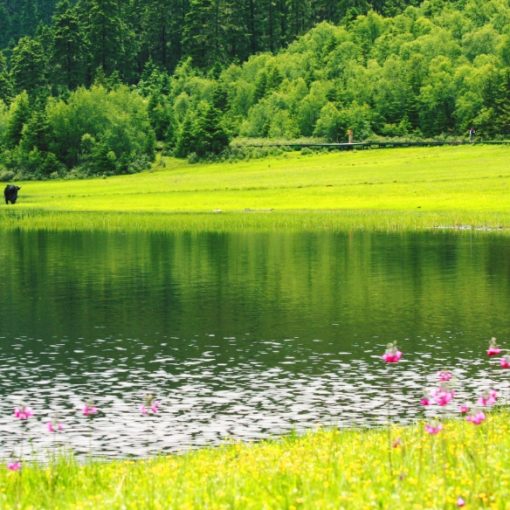Tiger Leaping Gorge
Tiger Leaping Gorge, nestled in the Yunnan Province of China, is one of the world’s deepest and most spectacular canyons. Stretching approximately 15 kilometers (about 9 miles) long, this natural wonder is renowned for its breathtaking scenery, dramatic landscapes, and adventurous trekking opportunities. In this comprehensive guide, we will explore everything you need to know about visiting Tiger Leaping Gorge, including its geography, history, trekking routes, travel tips, and more.

1. Brief Introduction
Tiger Leaping Gorge is a magnificent natural feature in Yunnan Province, China, formed by the Yangtze River cutting through the Hengduan Mountains. It is famous for its dramatic landscapes, where the river rushes through a deep gorge flanked by towering peaks. The name “Tiger Leaping Gorge” originates from a local legend that a tiger leapt across the river at its narrowest point to escape a hunter.
The gorge attracts trekkers and nature enthusiasts from around the globe who come to experience its rugged beauty and challenging trails. Whether you’re an experienced hiker or a casual traveler, Tiger Leaping Gorge offers a unique adventure in one of the most stunning natural settings in China.
2. Geography and Formation
Tiger Leaping Gorge is situated in the northwestern part of Yunnan Province, between the Haba Snow Mountain to the north and the Yulong Snow Mountain to the south. The gorge is carved by the Yangtze River (known as the Jinsha River in this region), which flows from the Tibetan Plateau through the deep valley.
The formation of Tiger Leaping Gorge is a result of tectonic activity and erosion. Over millions of years, geological forces have shaped the riverbed and surrounding mountains, creating the spectacular canyon we see today. The gorge is known for its extreme elevation differences, with the river at its lowest point being around 1,800 meters (5,900 feet) above sea level, and the surrounding peaks reaching up to 5,596 meters (18,360 feet).
3. Historical Significance
Tiger Leaping Gorge has a rich history that dates back thousands of years. The gorge has long been inhabited by ethnic minorities, including the Naxi and Bai people. These communities have developed unique cultures and traditions, deeply intertwined with the natural environment.
Historically, the gorge has also been a strategic location due to its rugged terrain. It served as a natural barrier and a trading route in ancient times, connecting different regions of China. The area has witnessed various historical events, including military skirmishes and trade exchanges, which have contributed to its cultural significance.
4. Ecology and Wildlife
Tiger Leaping Gorge is not only a geological marvel but also a hotspot for biodiversity. The diverse habitats within the gorge support a wide range of flora and fauna.
Flora
The gorge’s varied climate zones, ranging from temperate to subtropical, create a rich tapestry of vegetation. You can find a mix of evergreen forests, alpine meadows, and subtropical plant species. Common plants include pine trees, rhododendrons, and various wildflowers that add vibrant colors to the landscape.
Fauna
The wildlife in Tiger Leaping Gorge is equally diverse. The area is home to several species of mammals, birds, and insects. Some of the notable species include:
- Tibetan Macaque: These monkeys are often seen in the lower parts of the gorge, where they forage for food.
- Snow Leopard: Although elusive, snow leopards are known to inhabit the higher elevations of the gorge.
- Golden Pheasant: The gorge’s forests provide a habitat for this colorful and rare bird.
- Asian Black Bear: Found in the forested areas, these bears are a key part of the local ecosystem.
5. Trekking Routes
Tiger Leaping Gorge is renowned for its trekking opportunities, offering routes for various levels of hikers. Here are three popular trekking routes:
Route 1: Classic Trekking Route
Duration: 2 to 3 days
Distance: Approximately 20 kilometers (12.4 miles)
Difficulty: Moderate to challenging
The Classic Trekking Route is the most popular and well-trodden path in Tiger Leaping Gorge. It starts at Qiaotou, the gateway to the gorge, and takes you through stunning landscapes, including high mountain passes and lush valleys. Highlights of this route include:
- 28 Bends: A series of steep, switchback turns that provide panoramic views of the gorge.
- Halfway Guesthouse: A popular stopover offering stunning views and a chance to rest.
- Tina’s Guesthouse: Known for its hospitality and breathtaking views of the gorge.
Route 2: The Long-Distance Trail
Duration: 3 to 4 days
Distance: Approximately 35 kilometers (21.7 miles)
Difficulty: Challenging
The Long-Distance Trail offers a more immersive experience of Tiger Leaping Gorge, covering a greater distance and showcasing diverse landscapes. This route includes:
- Upper Tiger Leaping Gorge: The northern part of the gorge with dramatic cliffs and deep ravines.
- Longdong Waterfall: A beautiful waterfall that adds to the trail’s scenic allure.
- Daju: A charming village where trekkers can experience local culture and traditions.
Route 3: The Short Scenic Route
Duration: 1 day
Distance: Approximately 10 kilometers (6.2 miles)
Difficulty: Easy to moderate
For those with limited time or preferring a less strenuous hike, the Short Scenic Route offers a condensed version of the gorge’s highlights. It includes:
- Scenic Overlook Points: Ideal spots to capture the essence of the gorge’s beauty.
- Local Villages: Brief visits to traditional villages where you can interact with local people.
Map of Tiger Leaping Gorge

Itinerary:
- (From Lijiang or Shangri-La)
Qiaotou — Naxi Yage — 28 Bends — Shanjia Inn — Halfway — Tina’s — Heavenly Ladder — Zhang’s Home — Middle Tiger Leaping Gorge — One Line Sky — Walnut Garden — Old Ferry — Daju (Return to Lijiang or head to Shangri-La)Tips: After Middle Tiger Leaping Gorge, the route continues on the canyon road to Lower Tiger Leaping Gorge. If you have ample time and wish to visit Jade Dragon Snow Mountain, this route is highly recommended. If time is limited and you are not visiting Jade Dragon Snow Mountain, this route is not recommended as Daju may charge an additional scenic area management fee of 80 RMB plus the entrance fee for Jade Dragon Snow Mountain. - (From Lijiang or Shangri-La)
Qiaotou — Naxi Yage — 28 Bends — Shanjia Inn — Halfway — Tina’s — One Line Sky/Heavenly Ladder/Zhang’s Home — Canyon Road to Upper Tiger Leaping Gorge — Qiaotou (Return to Lijiang or head to Shangri-La) - (From Lijiang or Shangri-La)
Qiaotou — Upper Tiger Leaping Gorge — Canyon Road — Tina’s — One Line Sky/Heavenly Ladder/Zhang’s Home — Halfway — 28 Bends — Naxi Yage — Qiaotou (Return to Lijiang or head to Shangri-La)
Day-wise Itinerary:
Day 1:
Lijiang (or Shangri-La) — Tiger Leaping Gorge (2 hours) — Qiaotou (Store luggage) — Naxi Yage (2 hours) — 28 Bends (Dry Rock Room, about 1.5 hours) — Tea Horse Inn (1.5 hours) — Shanjia Inn — Halfway Accommodation (3 hours)
Day 2:
Halfway — Longdong Waterfall (1.2 hours) — Tina’s (1 hour) — Middle Tiger Leaping Gorge (1.5 hours) — One Line Sky — Heavenly Ladder — Zhang’s Home — Canyon Road — Upper Tiger Leaping Gorge — Qiaotou (Retrieve luggage) — Shangri-La (or Lijiang)
6. Travel Tips
Best Time to Visit
The best time to visit Tiger Leaping Gorge is during the spring (April to May) and autumn (September to October) when the weather is mild and the scenery is at its most vibrant. Summer can be hot and rainy, while winter may bring snow and freezing temperatures, making trekking more challenging.
Permits and Fees
Travelers need to obtain a permit to trek in Tiger Leaping Gorge. The permit can be purchased at the entrance to the gorge or through local travel agencies. There is also a small fee for using the trekking routes, which helps support the local community and maintain the trails.
Gear and Packing Tips
- Footwear: Sturdy hiking boots with good grip are essential for navigating the rugged terrain.
- Clothing: Dress in layers to accommodate changing weather conditions. Waterproof gear is recommended.
- Essentials: Bring plenty of water, snacks, a map, and a first-aid kit. A trekking pole can be helpful for stability on steep sections.
Safety Precautions
- Weather: Check the weather forecast before heading out and be prepared for sudden changes.
- Altitude: Be mindful of altitude sickness, especially if trekking at higher elevations.
- Local Wildlife: While encounters with wildlife are rare, it’s important to respect their habitat and maintain a safe distance.
Consultation:0887-8806899
Opening hour-7:30 Closing hour-16:00
Admission:45RMB
Consultation: 0887-8232533
7. Local Culture and Cuisine
Tiger Leaping Gorge is home to several ethnic groups, including the Naxi and Bai people. Their rich cultural heritage is reflected in their traditional customs, festivals, and cuisine.
Local Festivals
- Naxi Torch Festival: Celebrated in July, this festival involves torch-lit parades, traditional dances, and performances.
- Bai Three-course Tea Ceremony: A traditional tea ceremony performed during special occasions, showcasing Bai hospitality.
Local Cuisine
- Naxi-style Pancakes: Savory pancakes filled with vegetables and meat, a popular snack among locals and trekkers.
- Yak Meat: A staple in the region, often prepared in stews or stir-fries.
- Local Vegetables: Fresh and organic vegetables grown in the surrounding area are commonly used in dishes.
8. Accommodation Options
Accommodation in and around Tiger Leaping Gorge ranges from basic guesthouses to more comfortable lodges. Some popular options include:
- Halfway Guesthouse: Known for its stunning views and cozy atmosphere, a favorite among trekkers.
- Tina’s Guesthouse: Offers comfortable rooms and a restaurant with a variety of local and international dishes.
- Daju Village Homestays: Provides an opportunity to experience traditional village life and local hospitality.
9. How to Get There
From Lijiang:
Lijiang is the most common starting point for trips to Tiger Leaping Gorge. From Lijiang, you can take a bus or hire a private car to Qiaotou, the gateway to the gorge.
From Shangri-La:
Shangri-La is another popular starting point. You can take a bus or arrange transportation to Qiaotou, although the journey may be longer compared to departing from Lijiang.
10. Additional Attractions Nearby
- Yulong Snow Mountain: A stunning snow-capped mountain range offering various activities, including cable car rides and hiking.
- Lijiang Old Town: A UNESCO World Heritage Site known for its well-preserved ancient architecture and vibrant cultural scene.
- Shangri-La Old Town: Another historical town with Tibetan influence, featuring traditional buildings and local markets.
Tiger Leaping Gorge is a must-visit destination for anyone seeking adventure and natural beauty. With its awe-inspiring landscapes, challenging trekking routes, and rich cultural heritage, it offers a unique experience for travelers. Whether you’re a seasoned hiker or a casual explorer, Tiger Leaping Gorge promises an unforgettable journey through one of China’s most dramatic natural wonders.
By following this guide, you’ll be well-prepared to explore the majestic Tiger Leaping Gorge and make the most of your visit to this extraordinary location. Enjoy your adventure in one of the world’s most spectacular gorges!






